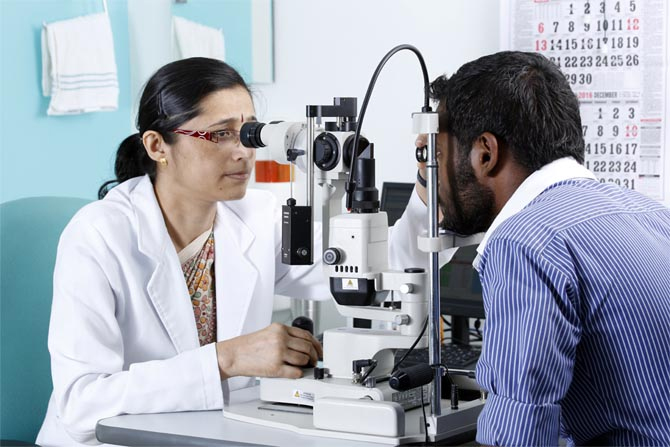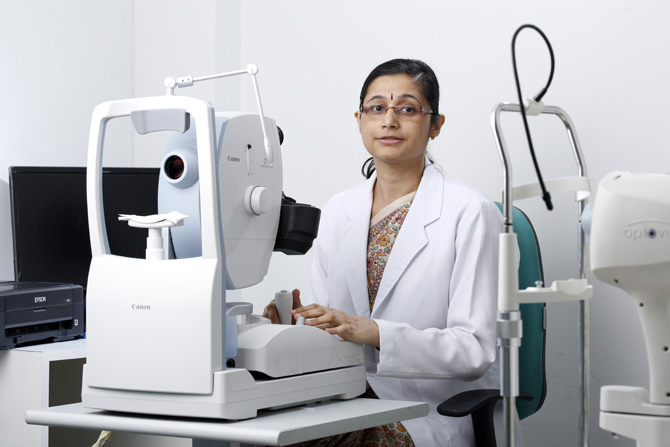+91 9645 600 032 | +91 9895 780 909
Mon to Sat 8.00 am to 6.00 pm
Restore vision clarity with Advanced Retina Treatments
Our Retina Specialists offer expert care for diverse retinal conditions, including retinal detachment, diabetic retinopathy, and age-related macular degeneration.
We closely evaluate patient conditions to prescribe laser therapy, intravitreal injections and vitrectomy for vision loss or floaters. With cutting-edge diagnostics and tailored interventions, our specialists ensure precise and effective care to restore optimal vision.
We provide the following facilities:
-
INDIRECT OPTHALMOSCOPY
-
OCT | FFA | B SCAN
-
INTRAVITREAL INJECTIONS
-
PRP (GREEN LASER)
-
FOCAL LASER
-
BARRAGE LASER
-
PDT
-
VITRECTOMY
Examining The Retina
A retinal examination also called as ophthalmoscopy or funduscopy. It allows the retinal specialist to evaluate the back of your eye, including your retina, optic disk and the underlying layer of blood vessels that nourish the retina (choroid). For a through retinal examination the pupils must be dilated using eye drops. The eyedrops used for dilation cause your pupils to widen, allowing in more light and giving your doctor a better view of the back of your eye.
-
The dilating eye drops may cause eye allergy in some individuals. Kindly specify to the doctor or optometrist if you have encountered such problems in the past.
-
The eye drops take time to act and may need to be repeated depending on the response.
-
The retinal examination usually takes less than 10 minutes, but it may take several hours for the effects of the dilating drops to wear off. Your vision will likely be blurry, and you may have trouble focusing on near objects
-
If the light bothers you, you may need to wear dark glasses (or sunglasses) for a short time
-
You may be uncomfortable driving with dilated pupils, so make sure you have transportation after your exam.
-
Depending on what you need to see at work, you might need to wear reading glasses or remove glasses that correct for nearsightedness until the effects of the eye drops wear off.
Symptoms and Detection
Many times, patients report no symptoms in the early stage of Diabetic Retinopathy. Patients experience following symptoms in the advance stage of this eye condition:
-
Fluctuating vision
-
Eye floaters and spots
-
Development of a scotoma or shadow in your field of view
-
Blurry and/or distorted vision
-
Corneal abnormalities such as slow healing of wounds due to corneal abrasions
-
Double vision
-
Eye pain
-
Near vision problems unrelated to presbyopia
-
Cataracts
The irregular growth of new blood vessels gives rise to serious complications such as retinal detachment, vitreous hemorrhage, glaucoma and blindness. Usually, this disease affects both eyes.
How Keratoconus is treated?
-
Depending on what you need to see at work, you might need to wear reading glasses or remove glasses that correct for nearsightedness until the effects of the eye drops wear off
-
Huge strides have been made in the treatment of diabetic retinopathy. Treatments such as scatter photocoagulation, focal photocoagulation, and vitrectomy prevent blindness in most people. The sooner retinopathy is diagnosed, the more likely these treatments will be successful. The best results occur when sight is still normal.
-
In photocoagulation, the eye care professional makes tiny burns on the retina with a special laser. These burns seal the blood vessels and stop them from growing and leaking.
-
In scatter photocoagulation (also called panretinal photocoagulation), the eye care professional makes hundreds of burns in a polka-dot pattern on two or more occasions. Scatter photocoagulation reduces the risk of blindness from vitreous hemorrhage or detachment of the retina, but it only works before bleeding or detachment has progressed very far. This treatment is also used for some kinds of glaucoma
-
Side effects of scatter photocoagulation are usually minor. They include several days of blurred vision after each treatment and possible loss of side (peripheral) vision.
-
In focal photocoagulation, the eye care professional aims the laser precisely at leaking blood vessels in the macula. This procedure does not cure blurry vision caused by macular edema. But it does keep it from getting worse.
-
When the retina has already detached or a lot of blood has leaked into the eye, photocoagulation is no longer useful. The next option is vitrectomy, which is surgery to remove scar tissue and cloudy fluid from inside the eye. The earlier the operation occurs, the more likely it is to be successful. When the goal of the operation is to remove blood from the eye, it usually works. Reattaching a retina to the eye is much harder and works in only about half the cases.





